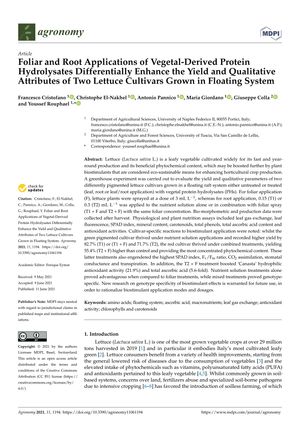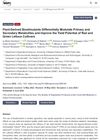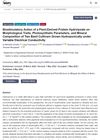Foliar and Root Applications of Vegetal-Derived Protein Hydrolysates Differentially Enhance the Yield and Qualitative Attributes of Two Lettuce Cultivars Grown in Floating System
June 2021
in “
Agronomy
”
vegetal-derived protein hydrolysates PHs foliar spray root application floating raft system SPAD index Fv/Fm ratio CO₂ assimilation stomatal conductance transpiration hydrophilic antioxidant activity total ascorbic acid protein hydrolysates floating system chlorophyll fluorescence ratio carbon dioxide assimilation antioxidant activity vitamin C

TLDR Protein hydrolysates applied to roots or leaves differently improved lettuce yield and quality, with the best results seen in specific combined treatments for each type.
The study explored the impact of vegetal-derived protein hydrolysates (PHs) on two lettuce cultivars, 'Ballerina' and 'Canasta', using different application methods in a floating raft system. The treatments included foliar spray, root application at two concentrations, and a combination of both. Results indicated that the green 'Ballerina' lettuce had a significant yield increase with treatments T1 or T1 + F (82.7%) and T2 (71.7%), while the red 'Canasta' lettuce showed the highest yield increase (55.4%) and improved phytochemical content with the combined treatment T2 + F. This treatment also enhanced the SPAD index, Fv/Fm ratio, CO₂ assimilation, stomatal conductance, and transpiration, with a notable increase in hydrophilic antioxidant activity (21.9%) and total ascorbic acid (5.6-fold) in 'Canasta'. Root applications were generally more effective than foliar applications, and the combined treatments had genotype-specific benefits. The study concludes that the effects of biostimulants are cultivar-dependent and that further research is necessary to tailor application methods and dosages for optimal hydroponic lettuce production.


